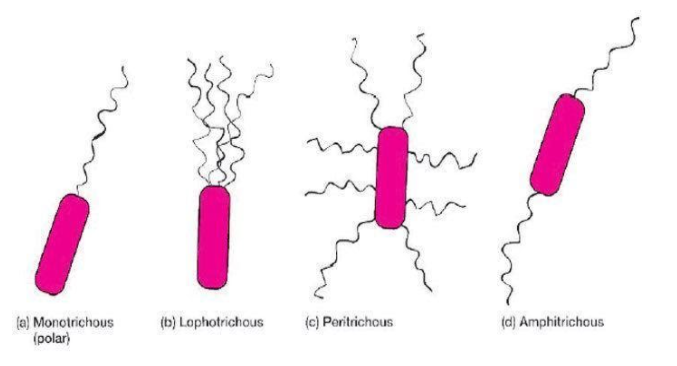
What are lateral appendages? Based on their presence and absence write the various types of flagella giving at least one example of each type?
Answer
584.1k+ views
Hint: Appendages are additional or outgrowth of a body part.
In bacteria the example of lateral appendage is flagella.
Flagella help in movement of bacteria from one place to another (locomotion).
We are not able to see them under the light microscope because they are too small in size.
Complete answer: In order to solve this question we need to know about the lateral appendages.
Appendages are an extra growth of any body part (such as in extremities) which can also be a natural protuberated part.
It is mainly found on the sides.
Lateral appendage generally means limbs on the sides.
Appendages include parts of mouth, parts of tail, gills in many animals, legs which can be for walking, climbing etc.
Appendages help in movement from one place to another, feeding and grooming.
In bacteria’s flagella is one the example of lateral appendages.
Flagella are a long locomotory structure present in many single cell organisms which help them in locomotion.
In some eukaryotic cells flagella is covered by the cell membrane.
In eukaryotes flagella moves in “s” shaped motion.
But we are not able to see the flagella on a microscope.
There are mainly four types of flagella.
1. Monotrichous: It means having one flagellum.
For example: vibrio cholera
2. Amphitrichous: It means single flagellum on both sides.
For example: Alkalinegens faecalis.
3. Lophotrichous: Tufts of flagella at one or both sides.
For example: spirillum
4. Peritrichous: they have flagella spread across the body except the poles.
For example: E.coli.
Look at the following diagram for better understanding.

Note: Cilia: It is a tiny, hair-like projection found on the cell surface of various mammals.
It can be single or present in groups.
Pseudopodia: It is cytoplasmic outgrowth seen in amoeba.
Pseudopodia also helps in locomotion in amoeba.
Due to the presence of pseudopodia in amoeba it helps in altering the shape of amoeba.
So, that’s why species of amoeba are known as proteus.
In bacteria the example of lateral appendage is flagella.
Flagella help in movement of bacteria from one place to another (locomotion).
We are not able to see them under the light microscope because they are too small in size.
Complete answer: In order to solve this question we need to know about the lateral appendages.
Appendages are an extra growth of any body part (such as in extremities) which can also be a natural protuberated part.
It is mainly found on the sides.
Lateral appendage generally means limbs on the sides.
Appendages include parts of mouth, parts of tail, gills in many animals, legs which can be for walking, climbing etc.
Appendages help in movement from one place to another, feeding and grooming.
In bacteria’s flagella is one the example of lateral appendages.
Flagella are a long locomotory structure present in many single cell organisms which help them in locomotion.
In some eukaryotic cells flagella is covered by the cell membrane.
In eukaryotes flagella moves in “s” shaped motion.
But we are not able to see the flagella on a microscope.
There are mainly four types of flagella.
1. Monotrichous: It means having one flagellum.
For example: vibrio cholera
2. Amphitrichous: It means single flagellum on both sides.
For example: Alkalinegens faecalis.
3. Lophotrichous: Tufts of flagella at one or both sides.
For example: spirillum
4. Peritrichous: they have flagella spread across the body except the poles.
For example: E.coli.
Look at the following diagram for better understanding.

Note: Cilia: It is a tiny, hair-like projection found on the cell surface of various mammals.
It can be single or present in groups.
Pseudopodia: It is cytoplasmic outgrowth seen in amoeba.
Pseudopodia also helps in locomotion in amoeba.
Due to the presence of pseudopodia in amoeba it helps in altering the shape of amoeba.
So, that’s why species of amoeba are known as proteus.
Recently Updated Pages
The number of solutions in x in 02pi for which sqrt class 12 maths CBSE

Write any two methods of preparation of phenol Give class 12 chemistry CBSE

Differentiate between action potential and resting class 12 biology CBSE

Two plane mirrors arranged at right angles to each class 12 physics CBSE

Which of the following molecules is are chiral A I class 12 chemistry CBSE

Name different types of neurons and give one function class 12 biology CBSE

Trending doubts
One Metric ton is equal to kg A 10000 B 1000 C 100 class 11 physics CBSE

Explain zero factorial class 11 maths CBSE

What is 1s 2s 2p 3s 3p class 11 chemistry CBSE

Discuss the various forms of bacteria class 11 biology CBSE

State the laws of reflection of light

An example of chemosynthetic bacteria is A E coli B class 11 biology CBSE




